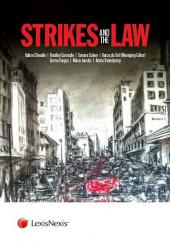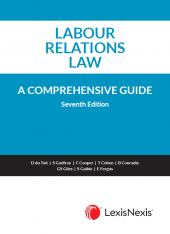Strikes and the Law
This publication provides up-to-date analysis of case law, legislation and policy developments relating to the law of industrial action in South Africa.
Select a format
One Year Subscription Only Terms
Subscribers receive the product(s) listed on the Order Form and any Updates made available during the annual subscription period. Shipping and handling fees are not included in the annual price.
Subscribers are advised of the number of Updates that were made to the particular publication the prior year. The number of Updates may vary due to developments in the law and other publishing issues, but subscribers may use this as a rough estimate of future shipments. Subscribers may call Customer Support at 800-833-9844 for additional information.
Subscribers may cancel this subscription by: calling Customer Support at 800-833-9844; emailing customer.support@lexisnexis.com; or returning the invoice marked 'CANCEL'.
If subscribers cancel within 30 days after the product is ordered or received and return the product at their expense, then they will receive a full credit of the price for the annual subscription.
If subscribers cancel between 31 and 60 days after the invoice date and return the product at their expense, then they will receive a 5/6th credit of the price for the annual subscription. No credit will be given for cancellations more than 60 days after the invoice date. To receive any credit, subscriber must return all product(s) shipped during the year at their expense within the applicable cancellation period listed above.
Product description
This publication provides up-to-date analysis of case law, legislation and policy developments relating to the law of industrial action in South Africa.
One of the greatest challenges facing South African labour relations is unprocedural and often violent industrial conflicts. Strikes and the law covers an analysis of the legislation and the case law and considers the reasons why in many cases, the law is disregarded. The Labour relations Amendment Bill, 2017 which was published in 17 November 2017 states that the root cause for protracted and often violent industrial action is a misalignment between the law on strikes and action taken by parties during industrial action. The authors consider this misalignment and suggest possible solutions. This is a critical read for labour law practitioners, HR/IR managers, trade unions and academics.
Note: The online price varies according to package chosen and number of users. Our sales agents will provide a quote on request.
Table of contents
CHAPTER_1 - Constitutional and International Law
1.1 - Historical context
1.2 - Justifications for the right to strike
1.3 - International law
1.4 - Use of the ILO observations and decisions by courts
1.5 - Constitutional law
1.6 - Approach to limitations on the right to strike
CHAPTER_2 - The socio-economic dimension of strikes
2.1 - Introduction
2.2 - Strike statistics: what can we learn?
2.3 - The prevalence of violence
2.4 - Unemployment, poverty and inequality
2.5 - Poverty and strike action
2.6 - The ANC's economic transformation agenda
2.7 - Structural drivers of unemployment, inequality and poverty
2.8 - The changing world of work
2.9 - Collective bargaining
2.10 - Conclusion
CHAPTER_3 - Protected strikes
3.1 - Introduction
3.2 - Definition of strike
3.3 - Requirements for protected strikes
3.4 - When statutory procedures may be dispensed with
3.5 - Consequences of a protected strike
3.6 - Replacement labour
3.7 - Are the current strike provisions effective?
3.8 - Interrogating the LRA's strike provisions
3.9 - What is the way forward?
CHAPTER_4 - Secondary strikes
4.1 - Introduction
4.2 - The context
4.3 - The international context
4.4 - The definition of secondary strike in South Africa
4.5 - Implementation of the law
4.6 - Procedural requirements
4.7 - Conclusion
CHAPTER_5 - Essential services
5.1 - Introduction
5.2 - Restrictions on the right to strike
5.3 - Designation of essential services
5.4 - The Essential Services Committee (ESC)
5.5 - Minimum services
5.6 - Maintenance services
5.7 - Conclusions
CHAPTER_6 - Unprotected strikes, interdicts and other remedies
6.1 - Introduction
6.2 - The scheme of the law
6.3 - Substantive limitations
6.4 - The consequences of unprotected strike action
6.5 - Implementation and enforcement of the law
6.6 - Can a protected strike become unprotected?
6.7 - A concluding view from the bench
CHAPTER_7 - Lock-outs
7.1 - Introduction
7.2 - Recourse to lock-out versus right to strike
7.3 - Definition of lock-out
7.4 - Prohibited demands
7.5 - Procedural requirements
7.6 - Circumstances when the statutory procedures may be dispensed with
7.7 - Locking out non-strikers in response to a strike
7.8 - Consequences of a protected lock-out
7.9 - Consequences of an unprotected lock-out
7.10 - Replacement labour
7.11 - Conclusion
CHAPTER_8 - Pickets, socio-economic protest action, gatherings and demonstrations
8.1 - Introduction
8.2 - Pickets
8.3 - Socio-economic protest action
8.4 - Demonstrations
8.5 - Unprotected and violent pickets, demonstrations and gatherings and socio-economic protests
8.6 - Conclusion
CHAPTER_9 - Dismissals
9.1 - Introduction
9.2 - International law
9.3 - From common law to constitutional protection
9.4 - Dismissal for misconduct during a protected strike, picket or protest action
9.5 - Dismissal for operational requirements arising out of a protected strike
9.6 - Dismissals to compel employees to accept changes to terms and conditions of employment
9.7 - Dismissal for participation in unprotected strike action
9.8 - Conclusion
Bibliography
Table of Cases
Table of Statutes
Index



